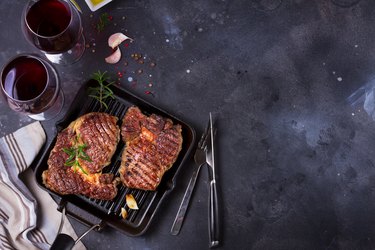
Steaks aren't all created equal. A blade steak will be extremely chewy and will need lots of help to be toothsome, while a rib steak or tenderloin is already as tender as beef can be. If you find yourself searching the internet for the best way to tenderize a ribeye steak, chances are that it's a problem with your cooking technique rather than the steak itself.
Toughness and Tenderizing Techniques
Video of the Day
When you're choosing a steak for grilling, it's important to understand a bit of basic anatomy. Generally, the more used a muscle, the tougher a piece of beef it will make. The heart, brisket and shoulder (chuck) cuts are typically rather tough and need long, slow cooking or some form of tenderizing, as do cuts from the hip, or "round."
Video of the Day
There are several ways to tenderize those cuts. The traditional at-home technique is to pound them with a mallet, which physically tears apart the tough strands of meat. That's also how the butcher's tenderizing machines do it, except they use various arrangements of blades or needles to achieve the same effect. Tenderizing powders use enzymes from tropical fruit to break down and soften the meat, and acidic marinades are traditional as well, though they're better at adding flavor than actually tenderizing meat.
Little-used muscles from the loin and rib area, on the other hand, are already tender and easy to chew. That's where your grilling steaks come from, and there's usually not any need to tenderize them.
Cooking Your Ribeye at High Temperature
However you cook your ribeye, the goal is much the same: your desired doneness in the center, with a nicely browned exterior and perhaps a hint of char. With a thin-cut ribeye of 1/2 inch or less, you'll need to cook it quickly at high heat in order to brown the outside before the interior is fully cooked.
Unfortunately, applying that same method to a thicker ribeye is just about the only way to make one tough and chewy. That high heat makes the muscle fibers contract and toughen, which in turn squeezes out the steak's moisture and leaves it dry. By the time the middle is cooked, the outsides can become leathery.
"Reverse Sear" the Ribeye
Skilled cooks have traditionally given thick steaks a good sear and then finished them at low heat to the correct doneness. Recently, science-minded chefs have discovered that doing things the other way around – low-temperature cooking followed by a high-temp sear – gives even better results.
Indoors, you can do the steak in a low oven (or a sous-vide bath) and then finish it in a hot pan. Outdoors on the grill, you'd heat just one side of the grill and cook the steak lid-down on the unheated side until it's ready to sear. If you do this, the steak should be juicy and not tough.
Best Marinade for a Ribeye Steak
If your ribeye steak is low-end "choice" grade rather than "select" or the very pricey "prime," it should still be tender. If you want to stack the deck in favor of tenderness anyway, forget about the traditional methods of pounding and marinating. The best marinade for your ribeye isn't a marinade at all but something simpler: salt.
Just sprinkle your steaks generously with coarse kosher or pickling salt at least 45 to 60 minutes before cooking them. The salt draws juices from your steak during that time, but they're absorbed back into the meat before you cook it. Just brush off the salt, give it a quick rinse and then blot it dry with paper towel before you cook it. The salt will season the steak nicely, improve its texture and make it a little more tender, and as a bonus, it will also be juicier than it would have been otherwise.
If you'd like to use a marinade as well for flavor, a mixture of Worcestershire sauce and soy sauce with added garlic and onion powder will add plenty of savory umami to your steak. It just takes a moment: Mix it up, brush it on and then pat the steaks dry with a paper towel so they'll brown nicely. Enough marinade will linger in the meat's crevices to make it tastier. The same technique also works with any marinade you already use and enjoy.